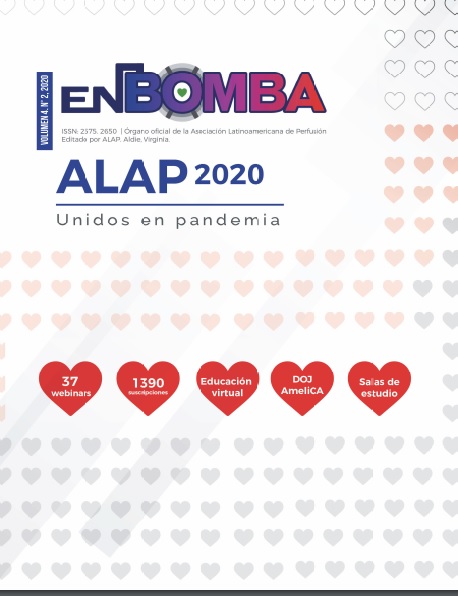Perfusion strategies in rare diseases: glucose 6 phosphate dehydrogenase deficiency.
Keywords:
Glucose-6-phosphate dehydrogenase, Cardiopulmonary bypass, Hemolysis, Oxidative stress, NADPHAbstract
Glucose-6-phosphate dehydrogenase is an erythrocyte enzyme whose function is to maintain the homeostasis of red blood cells against oxidative stress through the production of reduced nicotinamide adenine dinucleotide phosphate. Consider-ing that the unwanted clinical manifestations of this enzyme disorder are multifactorial, in these patients who undergo cardiac surgery, extracorporeal circulation is a trigger for oxidative stress, which leads to hemolytic events and the pro-duction of free radicals. We present a case of a 3-year-old male, weighing 7.6 kg and body surface area of 0.39 m2 known with a diagnosis of congenital heart disease, and class III Glucose-6-phosphate dehydrogenase deficiency, who underwent correction of perimembranous ventricular septal defect plus debanding of the pulmonary artery. Induction was performed with total intravenous anesthesia. After heparinization, a crystalloid-hematic priming cardiopulmonary bypass was started with a total volume of 180 ml, the composition of which was the following: Multilytos R® (Laboratorios ALFA, Santo Do-mingo, República Doninicana), 50 ml multielectrolytic solution and 130 ml globular pack. At the beginning of cardio-pulmonary, mannitol (Osmorol, Laboratorios PISA, México DF, Mexico), 0.5 g/kg), NaHCO (32 mEq/kg) and sodic heparin (Laboratorios CRISTALIA, São Paulo, Brasil), 100 IU/kg. Calibration of the arterial roller was performed by the water column drop method and corroborated with the dynamic method. During the pump 1 g. Ascorbic Acid (Vitamina C, Laboratorios SINTESIS, Santo Domingo, República Dominicana), 0.25 mg/kg of Furosemide (Lasix, Laboratorios SANOFI AVENTIS, Massachusetts, Estados Unidos de América). Procedure ran without incident until weaning from extracorporeal circulation. Lactate, glycemia and arterial blood gas controls were carried out. The duration of cardiopul-monary bypass was 102 minutes and the aortic clamping was 88 minutes. Diuresis of 17ml (1.2 ml/kg/h.), we observed presence of hemoglobinuria. He was transferred to the intensive care unit in normothermia and in stable general conditions. Was extubated 5 hours after surgery without incident. Laboratory tests were performed to assess hemolytic disorders without major alterations. Discharged on the eighth day without any eventuality or complication related to the enzyme deficiency of Glucose-6-phosphate dehydrogenase. Conclusion: The application of the measures described in this article did not prevent the appearance of hemolysis in this patient, but it was possible to prevent it from causing greater damage at the renal and pulmonary level and also the expression of an exaggerated inflammatory response.
Downloads
Published
How to Cite
Issue
Section
License
Los trabajos admitidos para publicación quedan en propiedad de los autores y su reproducción total o parcial está autorizada siempre y cuando se haga referencia a la fuente primaria y no se persigan fines comerciales (Licencia CC Reconocimiento-NoComercial 4.0). La Revista En bomba se reserva el derecho de reproducir (parcial o totalmente) sus publicaciones así reproducir sus contenidos en otros medios o soportes digitales o físicos.








